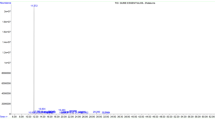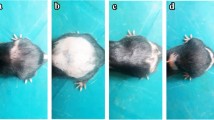Abstract
Cancer is the leading cause of death worldwide. Cyclophosphamide (CTX) is commonly used as anticancer drug which causes toxicity by its reactive metabolites such as acroline and phosphoramide mustard. In this study, Cuscuta chinensis (C. chinensis) (family: Convolvulaceae) was assessed for ability to restore mice against CTX-induced toxicity. Coadministration of C. chinensis extract (10 mg/kg BW, IP, daily) for ten consecutive days reduced CTX-induced (25 mg/kg BW, IP, daily) toxicity. Treatment with C. chinensis extract significantly (p < 0.01) increased the relative organ weight and body weight. Moreover, administration of C. chinensis extract significantly increased bone marrow cellulatity and α-esterase activity in CTX-treated mice which suggested its protective role on the hematopoietic system. The GSH content was drastically reduced by CTX administration in urinary bladder which was enhanced by treatment with C. chinensis extract, indicating that preventing acroline-mediated tissue damage or cell toxicity and also the extract decreased the urinary bladder nitric oxide (NO) level which proves recovery over urinary tract injury associated with CTX treatment. The administration of C. chinensis extract decreased serum urea, creatinine, and bilirubin levels when compared to CTX-alone-treated group. Histopathological analysis of the urinary bladder of CTX-alone-treated group showed necrotic damage whereas the C. chinensis-treated group showed normal bladder architecture. The above data clearly demonstrates chemoprotective role of C. chinensis against CTX-induced toxicities by regulating antioxidant and inflammatory mediators.




Similar content being viewed by others
References
Weinberg, R. A. (1996). How cancer arises? Scientific American, 275, 32–440.
Baskar, R., Lee, K. A., Yeo, R., & Yeoh, K. W. (2012). Cancer and radiation therapy: current advances and future directions. International Journal of Medical Sciences, 9, 193–199.
Siegel, R. (2012). Cancer treatment and survivorship statistics. Ca Cancer Journal for Clinicians, 62(4), 220–241.
Wilson, C.O., Beale, J.M., Block, J.H. (2011). Wilson and Gisvold’s textbook of organic medicinal and pharmaceutical chemistry (11nd ed.) Lippincott Williams & Wilkins, Baltimore, MD, 43-45.
Balch, C. M., Houghton, A. N., Peters, L., De Vita, V. T., Hellman, S., & Rosenberg, S. A. (1993). Cancer: principles and practice of oncology (4th ed., pp. 1499–1542). Philadelphia PA: JB Lippinocott.
Grochow, L. B. (1996). Covalent DNA-binding drugs. In M. C. Perry (Ed.), The chemotherapy source book (pp. 297–299). Baltimore: Williams & Wilkins.
Monach, P., Arnold, L., & Merkel, P. (2010). Incidence and prevention of bladder toxicity from cyclophosphamide in the treatment of rheumatic diseases. Arthritis and Rheumatism, 62, 9–21.
Dumontet, C., Drai, J., Thieblemont, C., Hequet, O., Espinouse, D., & Bouafia, F. (2001). The superoxide dismutase content in erythrocytes predicts short-term toxicity of high dose cyclophosphamide. British Journal of Haematology, 112, 405–409.
Vinod Prabhu, V., & Guruvayoorappan, C. (2012). Evaluation of immunostimulant activity and chemoprotective effect of mangrove Rhizophora apiculata against cyclophosphamide induced toxicity in BALB/c mice. Immunopharmacology and Immunotoxicology, 34, 608–615.
Pratheeshkumar, P., & Kuttan, G. (2010). Cardiospermum halicacabum inhibits cyclophosphamide induced immunosupression and oxidative stress in mice and also regulates iNOS and COX-2 gene expression in LPS stimulated macrophages. Asian Pacific Journal of Cancer Prevention, 11, 1245–1252.
Santos, A. A., Jr., Lealm, P. C., Edelweiss, M. I., Lopes, T. G., Calixto, J. B., Morrone, F. B., & Campos, M. M. (2010). Effects of the compounds MV8608 and MV8612 obtained from Mandevilla velutina in the model of hemorrhagic cystitis induced by cyclophosphamide in rats. Naunyn-Schmiedeberg's Archives of Pharmacology, 382, 399–407.
Sakthivel, K. M., & Guruvayoorappan, C. (2014). Acacia ferruginea inhibits cyclophosphamide-induced immunosuppression and urotoxicity by modulating cytokines in mice. Journal of Immunotoxicology, 29, 1–10.
Hajimehdipoor, H., Kondori, B. M., Amin, G. R., Adib, N., Rastegar, H., & Shekarchi, M. (2012). Development of a validated HPLC method for the simultaneous determination of flavonoids in Cuscuta chinensis Lam. by ultra-violet detection. Daru, 20(57), 1–6.
Sun, S. L., Guo, L., Ren, Y. C., Wang, B., Li, R. H., Qi, Y. S., Yu, H., Chang, N. D., Li, M. H., & Peng, H. S. (2014). Anti-apoptosis effect of polysaccharide isolated from the seeds of Cuscuta chinensis Lam on cardiomyocytes in aging rats. Molecular Biology Reports, 41, 6117–6124.
Liao, J. C., Chang, W. T., Lee, M. S., Chiu, Y. J., Chao, W. K., Lin, Y. C., Lin, M. K., & Peng, W. H. (2014). Antinociceptive and anti-inflammatory activities of Cuscuta chinensis seeds in mice. American Journal of Chinese Medicine, 42, 223–242.
Yen, F. L., Wu, T. H., Lin, L. T., & Lin, C. C. (2007). Hepatoprotective and antioxidant effects of Cuscuta chinensis against acetaminophen-induced hepatotoxicity in rats. Journal of Ethnopharmacology, 111, 123–128.
Yen, F. L., Wu, T. H., Lin, L. T., Cham, T. M., & Lin, C. C. (2008). Nanoparticles formulation of Cuscuta chinensis prevents acetaminophen-induced hepatotoxicity in rats. Food and Chemical Toxicology, 46, 1771–1777.
Yang, L., Chen, Q., Wang, F., & Zhang, G. (2011). Antiosteoporotic compounds from seeds of Cuscuta chinensis. Journal of Ethnopharmacology, 135, 553–560.
Prabhu, V. V., & Guruvayoorappan, C. (2012). Anti-inflammatory and anti-tumor activity of the marine mangrove Rhizophora apiculata. Journal of Immunotoxicology, 9, 341–352.
Bancroft, J. D., & Cook, H. C. (1984). Manual of histological techniques (pp. 171–178). London: Churchill Livingston.
Beutler, E., Duron, O., & Kelly, B. M. (1963). Improved method for the determination of blood glutathione. Journal of Laboratory and Clinical Medicine, 61, 882–888.
Green, L. C., Wagner, D. A., Glogowski, J., Skipper, P. L., Wishnok, J. S., & Tannenbaum, S. R. (1982). Analysis of nitrate, nitrite and (15 N) nitrate in biological fluids. Analytical Biochemistry, 126, 131–138.
Donald, R., Wybenga Giorgio, J. D., & Pileggi, V. J. (1971). Manual and automated methods for urea nitrogen measurement in whole serum. Clinical Chemistry, 17, 891–895.
Nicolini, A., Mancini, P., Ferrari, P., Anselmi, L., Tartarelli, G., Bonazzi, V., Carpi, A., & Giardino, R. (2004). Oral low-dose cyclophosphamide in metastatic hormone refractory prostate cancer (MHRPC). Biomedicine and Pharmacotherapy, 58, 447–450.
Singh, G., Fries, J. F., Williams, C. A., Zatarain, E., Spitz, P., & Bloch, D. A. (1991). Toxicity profiles of disease modifying antirheumatic drugs in rheumatoid arthritis. Journal of Rheumatology, 18, 188–194.
Lohrmann, H. P. (1984). The problem of permanent bone marrow damage after cytotoxic drug treatment. Oncology, 41, 180–184.
Bernatsky, S., Clarke, A. E., & Suissa, S. (2008). Hematologic malignant neoplasms after drug exposure in rheumatoid arthritis. Archives of Internal Medicine, 168, 378–381.
Rudra, P. K., & Krokan, H. E. (1999). Acrolein cytotoxicity and glutathione depletion in n-3 fatty acid sensitive- and resistant human tumor cells. Anticancer Research, 19, 461–469.
Arrigo, A. P. (1999). Gene expression and the thiol redox state. Free Radical Biology and Medicine, 27, 936–944.
Kehrer, J. P., & Biswal, S. S. (2000). The molecular effects of acrolein. Toxicological Sciences, 57, 6–15.
Van den Dobblesteen, D. J., Nobel, C. S., Schlegel, J., Cotgreave, I. A., Orrenius, S., & Slater, A. F. (1996). Rapid and specific efflux of reduced glutathione during apoptosis induced by anti-Fas/APO-1 antibody. Journal of Biological Chemistry, 271, 15420–15427.
Horton, N. D., Biswal, S. S., Corrigan, L. L., Bratta, J., & Kehrer, J. P. (1999). Acrolein causes IκB-independent decreases in NF-κB activation in human lung adenocarcinoma (A549) cells. Journal of Biological Chemistry, 274, 9200–9206.
Dole, M. G., Jasty, R., Cooper, M. J., Thompson, C. B., Nunez, G., & Castle, V. P. (1995). Bcl-xL is expressed in neuroblastoma cells and modulates chemotherapy-induced apoptosis. Cancer Research, 55, 2576–2582.
Manaloor, E. J., Neiman, R. S., Heilman, D. K., Albitar, M., Casey, T., Vattuone, T., Kotylo, P., & Orazi, A. (2000). Immunohistochemistry can be used to subtype acute myeloid leukemia in routinely processed bone marrow biopsy specimens. Comparison with flow cytometry. American Journal of Clinical Pathology, 113, 814–822.
Gasson, J. C. (1991). Molecular physiology of granulocyte-macrophage colony-stimulating factor. Blood, 77, 1131–1145.
Dinarello, C. A. (2000). Interleukin-18, a proinflammatory cytokine. European Cytokine Network, 11, 483–486.
Ma, Q., & Kinneer, K. (2002). Chemoprotection by phenolic antioxidants. Inhibition of tumor necrosis factor alpha induction in macrophages. Journal of Biological Chemistry, 277, 2477–8244.
de Oliveira Silveira, A. C., Leite, E. A., Melo, M. M., de Carvalho Ribeiro, A. F., Cassali, G. D., de Souza, C. M., Souza-Fagundes, E. M., Caldas, I. R., Araújo, M. S., Martins-Filho, O. A., de Oliveira, M. C., & Teixeira-Carvalho, A. (2012). Antitumor effectiveness and toxicity of cisplatin-loaded long-circulating and pH-sensitive liposomes against Ehrlich ascitic tumor. Experimental Biology and Medicine (Maywood, N.J.), 237, 973–84.
Tarcic, N., Ovadia, H., Weiss, D. W., & Weidenfeld, J. (1998). Restraint stress- induced thymic involution and cell apoptosis are dependent on endogenous glucocorticoids. Journal of Neuroimmunology, 82, 40–46.
Popa, I., Zubkova, I., Medvedovic, M., Romantseva, T., Mostowski, H., Boyd, R. L., & Zaitseva, M. (2007). Regeneration of the adult thymus is preceded by the expansion of K5 K8 epithelial cell progenitors and by increased expression of Trp63, cMyc and Tcf3 transcription factors in the thymic stroma. International Immunology, 19, 1249–1260.
Malik, S. W., Myers, J. L., DeRemee, R. A., & Specks, U. (1996). Lung toxicity with cyclophosphamide use: two distinct patterns. American Journal of Respiratory and Critical Care Medicine, 154, 1851–1856.
Limper, A. H. (2004). Chemotherapy-induced lung disease. Clinics in Chest Medicine, 25, 53–64.
Limper, A. H., & Rosenow, E. C. (2000). Drug-induced pulmonary disease. In J. F. Murray & J. Nadel (Eds.), Textbook of respiratory medicine (pp. 1971–194). Philadelphia: W.B. Saunders Company, Inc.
Ishak, K. G., & Zimmerman, H. J. (1995). Morphologic spectrums of drug-induced liver disease. Gastroenterology Clinics of North America, 24, 759–786.
King, P. D., & Perry, M. C. (2001). Hepatotoxicity of chemotherapy. The Oncologist, 6, 162–176.
Al-Yahya, A. A., Al-Majed, A. A., Gado, A. M., Daba, M. H., Al-Shabanah, O. A., & Abd-Allah, A. R. (2009). Acacia Senegal gum exudate offers protection against cyclophosphamide-induced urinary bladder cytotoxicity. Oxidative Medicine and Cellular Longevity, 2, 207–213.
Moraes, J. P., Pereira, D. S., Matos, A. S., Santana, D. G., Santos, C. A., Estevam, C. S., Fakhouri, R., de Lucca Junior, W., & Camargo, E. A. (2013). The ethanol extract of the inner bark of Caesalpinia pyramidalis (Tul.) reduces urinary bladder damage during cyclophosphamide-induced cystitis in rats. Scientific World Journal, 20, 1–8.
Acknowledgments
The valuable support of Dr. Jannet Vennila, Director, School of Biotechnology and Health Sciences, Karunya University, is greatly acknowledged.
Conflict of Interest
The authors report no conflicts of interest.
Author information
Authors and Affiliations
Corresponding author
Rights and permissions
About this article
Cite this article
Raju, N., Sakthivel, K.M., Kannan, N. et al. Cuscuta chinensis Ameliorates Immunosuppression and Urotoxic Effect of Cyclophosphamide by Regulating Cytokines - GM-CSF and TNF-Alpha. Appl Biochem Biotechnol 176, 742–757 (2015). https://doi.org/10.1007/s12010-015-1608-0
Received:
Accepted:
Published:
Issue Date:
DOI: https://doi.org/10.1007/s12010-015-1608-0




